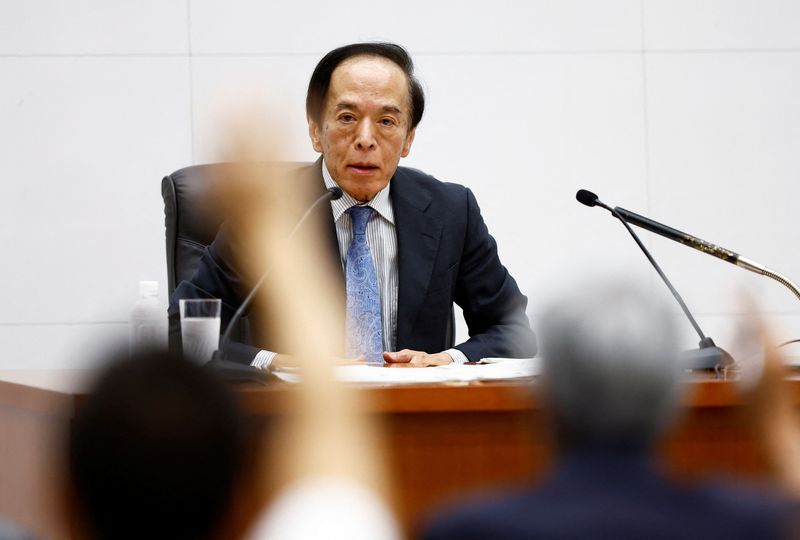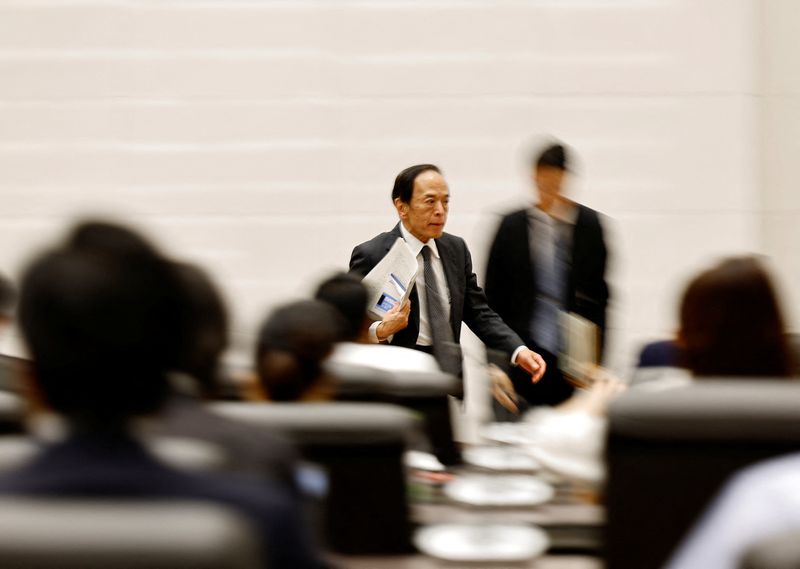By Leika Kihara and Takaya Yamaguchi
TOKYO (Reuters) -The Bank of Japan raised interest rates to levels unseen in 15 years and unveiled a detailed plan to slow its massive bond buying, taking another step towards phasing out a decade of huge stimulus.
The rate hike, which dashed dominant market expectations for no change, was the largest since 2007 and came just months after the BOJ ended eight years of negative interest rates as the bank's chief seeks to dismantle his predecessor's unorthodox policies.
BOJ Governor Kazuo Ueda did not rule out another hike this year and stressed the bank's readiness to keep raising borrowing costs to levels deemed neutral to the economy.
The hawkish comments pushed the dollar below 151 yen for the first time since March, as markets awoke to the reality that Japan was finally eyeing a full-fledged rate hike cycle.
Japan's shift to tighter monetary policy contrasts sharply with the broad swing to lower interest rates by other major economies, with the Federal Reserve expected to signal later on Wednesday that it will cut rates in September as U.S. price pressures moderate.
"If data shows economic conditions are on track, and if such data accumulates, we would of course take the next step," Ueda told a news conference, when asked about the chance of another rate hike this year.
"By raising rates from very low levels and adjusting the degree of stimulus gradually, we can avoid the risk of having to make big adjustments in a short period of time," he said.
At the two-day meeting ending on Wednesday, the BOJ's board decided to raise the overnight call rate target to 0.25% from 0-0.1% in a 7-2 vote. The short-term policy rate is now the highest since 2008.
The BOJ under Ueda has so far hiked rates by a combined 35 basis points in just four months.
Wednesday's hike was the largest since a 25 basis point increase in February 2007, which was the last major policy tightening before a long era of massive monetary stimulus aimed at reflating sluggish consumer demand.
In a sign Ueda was drawing a line under the ultra-loose policies of the past, the BOJ also decided on a quantitative tightening (QT) plan that would halve monthly bond buying to 3 trillion yen ($19.6 billion) as of January-March 2026.
The measure would diminish the BOJ's $3.9 trillion balance sheet by up to 8%, the central bank said, a sign it was stepping back from a controversial era of bond buying that began in 2013 and is often blamed for distorting Japan's markets.
The stakes are high for the BOJ. After buying bonds aggressively to reflate growth, the BOJ now owns roughly half of total Japanese government bonds (JGB) sold in the market.
The central bank must tread cautiously in tapering to avoid upending markets accustomed to its huge presence, and triggering a spike in yields that would boost the cost of financing Japan's huge public debt.
YEN PRESSURES
The BOJ's decision comes as the Fed looks increasingly set on cutting rates, reversing the aggressive tightening cycle that drove up the dollar and caused a painful yen sell-off for Japan.
Ueda identified the weak yen as a risk to the BOJ's inflation projections and said the 0.5% threshold posed no barrier to rates going even higher, if needed.
His comments helped pushed the yen up more than 1% to an intraday high of 150.61 per dollar on Wednesday.
Short-term bond yields scaled 15-year peaks and Japanese bank shares soared, helping the Nikkei share average reverse earlier declines.
"Despite sluggish consumer spending, monetary officials sent a decisive signal by raising interest rates and allowing for a more gradual balance sheet reduction," said Fred Neumann, chief Asia economist at HSBC.
"Rising inflation expectations also open the path for ongoing monetary policy normalisation by the BOJ. Barring major disruptions, the BOJ is on course to tighten further, with another interest hike by the start of next year," he said.
In a quarterly outlook report released on Wednesday, the BOJ roughly maintained its projection made in April that inflation would stay around 2% through fiscal 2026.
But the BOJ said import prices were again accelerating despite some recent moderation, stressing the need to be vigilant to the risk of an overshoot in inflation.
The BOJ also warned that inflation may be more affected by yen moves than before, signaling its alarm over building inflationary pressure from the currency's declines.

"Although the BOJ had explained all along that monetary policy was not about targeting currencies, the weak yen must have been a major factor behind today's decision given that it was dealing a blow to small firms in rural regions," said Izuru Kato, chief economist at Totan Research.
($1 = 152.7500 yen)
